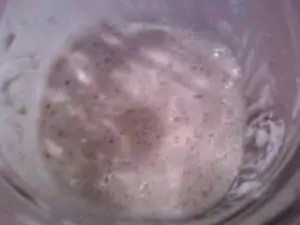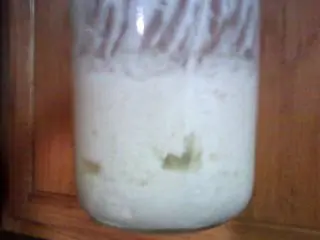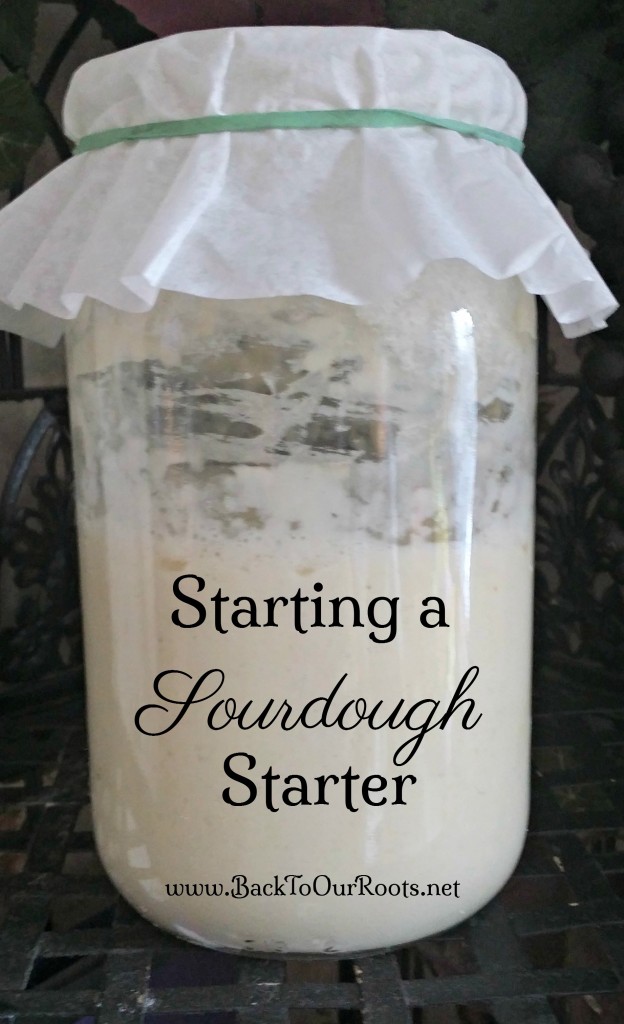In case you missed it, here’s Part 1.
Feeding number 2
OK, here we are ready for feeding number 2.
When I got up this morning, this is what my starter looked like.

Right before feeding #2
See all the bubbles?
Yeah!
And notice that the hooch isn’t on the top this time, it’s close to the bottom.
Actually, there is a little bit everywhere.
Make sure you stir that back in. It’s what keeps the bad bacteria and mold from growing.
The fermentation process also begins to break down the grains in your flour which releases the vitamins, minerals, and other nutrients in the flour.
So your body is able to absorb these nutrients faster and not lose so much of them through waste.
Of course, the type of flour you use determines the amount of nutrients available.
Bleached, enriched flour has fewer natural nutrients than any other flour.
Stone ground, whole grain flours have the most.
So, the more processing, the less nutrients.
The flour I’m using for this starter is organic, unbleached white flour, but I also have one made with organic, stone ground whole wheat flour.

Inside the jar before feeding number 2
So, here’s a picture of the top.
See the bubbles?
This one is going really well.
Oh, and the darkish stuff is just shadows.
Really. 🙂
Now remember that yours may not look exactly like mine and that’s OK.
I have had some starters that didn’t do anything for 3 days.
Just to clarify something here in case I have confused anyone – you don’t have to make a new starter every time you make bread.
I have made several using different flours and temperatures of water and even types of water, trying to find the easiest and best way.
What I have found is that it doesn’t matter what kind of flour you use, or whether you use tap or bottled water.
The starter is going to work with pretty much anything.
The only concern would be if you don’t drink your water because of contaminants, you might want to use filtered water for your sourdough.
Since you’re going to be eating it and all.
Some instructions specify using cold water when feeding the starter. I’m not sure why, though. I usually use warm water.
But be careful, if the water it too hot, it may kill the yeast. (That is only an assumption on my part, since I have never used hot water.)
Now, I stir it down and remove about 1/2 of what is in the jar.
Then I add 1/4 cup water and 3/8 cup flour.
Stir it up, scrape down the sides, and put the frilly little bonnet back on.
This is what it looked like after the feeding.

Right after feeding #2
And by the way, I don’t want you to drive yourself crazy over exact measurements.
I use my 1/4 cup measuring cup, fill it with warm tap water and dump it in the jar.
Then I stir in the water, dry out the measuring cup and put it in the flour jar.
I use what I’ve heard called the “scoop and sweep” method.
You “scoop” up some flour with the measuring cup and use your finger to “sweep” across the top to make it level(ish).
Then I dump that 1/4 cup of flour in the jar and refill my 1/4 cup about 1/2 way with flour and dump that in the jar for a total of 3/8 cup of flour.
Then stir it all up.
Bread making can be more of an art than a science at times.
So, don’t be intimidated by the long process here with the starter, or fret over measurements.
Just have fun!!
Feeding number 3
OK, time for feeding number 3.
This is what it looked like before I stirred it down.

Before 3rd feeding
So, there is more hooch and more bubbles, just as it should be.
Here is a picture inside the jar.

Inside jar before 3rd feeding
You can’t really see very well, (I’m using my phone for pictures), but there is a little bit of foam as well as bigger bubbles on the top.
That is perfectly OK.
In fact, that’s good!
Now, stir it down, remove about half of what is in the jar, and feed it the same amount of water and flour as before.
And here it is after feeding number 3.

After feeding number 3
I put it in a clean jar so it would be easier for you to see what it looks like.
I would not normally do that, but ya’ll are special!
OK, 3 feedings down and 11 more to go!
I’ll continue to post pictures as we go through the process, but it’s just the same thing we’ve been doing.
Stir it down, remove half, and feed.
Now, you may be asking, what in the world am I going to do with it when it’s ready?
Besides making the bread, of course.
Well, I’ve made bread bowls, pizza crust, crackers, pancakes, and English muffins.
I have also made waffles, muffins, biscuits, tortillas, pita bread, and even chocolate cake.
As I take you through the starter process, I’m going to be sharing with you some things to use the sourdough in.
Blessings!

Kathleen says
Anyone else unable to see the pictures?
Cery says
Hi Kathleen,
Thanks for the heads up on the pictures! They are all fixed now.
Blessings!
Mother of Five says
Thank you for all your in depth descriptions and how-to’s! I’m excited to go and start my very own sourdough starter today! You made it look so easy! I remember my mom’s homemade bread. I can’t wait to make it for my children. The smell is intoxicating!
Cery says
Hi Mother of Five! You are very welcome. I’m so happy that you are going for it. SO many amazing smells ahead, lol. Blessings!
Nancy says
Thanks for the information. I would like to know how to to make my sourdough bread notsosour.
Cery says
Hi Nancy! I’m not a huge fan of the super sour stuff, myself.
The sour taste is directly proportional to the amount of time it takes to rise. The longer it takes, the more “hooch” forms in the dough.
You can mitigate that by adding some commercial yeast, or by keeping the dough close to something warm as it’s rising. Like a crockpot or in an oven with the light on.
Hope that helps!
Blessings!
Kim Murdoch says
My starter has been going for about a month. It doesn’t look as active as yours. I feed it morning and night, and discard as directed. It produces hooch and smells like it should. However my loaves don’t rise. The dough rises and doubles the first rise. The second rise it seems to become flat. The bread bakes up very dense and is not risen…. HELP?
Cery says
Hi Kim! That’s a common thing with sourdough. Try adding a little more flour when you feed it. It may not be getting enough to eat. If that is the issue, it should become more active quite quickly.
As for the 2nd rise problem, try not letting it rise as much the first time. Sometimes the first rise is too long and there’s not enough “activity” left for the second one. I would start by halving the time I let it rise the first time. Give that a try and see if that works for you.
Blessings!
Joyce says
Am I to remove half from my jar at every feedi g or just in the morning?
Cery says
Hi Joyce! You will remove half every time you feed it unless you are getting ready to use it.
Blessings!
Jill says
I started with a kit from San Francisco Sourdough (is that cheating???). Can I share my discards for someone to start their own and if so, do they just pick up as though it’s day 2?
Cery says
Totally not cheating! lol Yes, you can share the discards for starting new ones. And starting with day 2 is perfect. Blessings!
Denisa says
Thank you for the detailed instructions. I just have one question , how much of the starter do I use to make my first bread , do I use all of it or do I save some for next time ? I know you mentioned to feed it once a week after the starter is ready but how long does this last and how do you know when it has gone bad and you need a new starter ?
Cery says
Hi Denisa!
You can find the recipe for basic bread here: https://www.backtoourroots.net/sourdough-101-part-the-last-bread-recipe/.
You will need to build up the starter to have enough for the recipe and some to save. That link goes through how to build it up so there is enough.
You can feed the starter once a week if you keep it in the fridge. Let it come to room temp before you feed it. Then let it bubble up before you put it back in the fridge.
The fermentation slows down in the cold, so the yeast isn’t as active and it doesn’t need to be fed that often. Every 7 to 10 days is usually ok.
As long as there isn’t mold on the top of the starter it is still good. Starters can last hundreds of years if fed regularly.
Cery
Rachel Biehl says
Hi there, this is my first time trying sourdough starter, I have done four feedings so far. However, my starter seems to be producing a lot of hooch, and not long after I’ve fed it. I’m wondering if my kitchen is too warm for it and it’s fermenting too quickly, maybe? The hooch is mostly on top, with a small layer of foam on it. It looks bubbly underneath and smells a little funky, haha. Any thoughts on this? Thank you!
Cery says
Hello Rachel!
It’s most likely that it’s not getting quite enough to eat. Try adding a little more flour when you feed it so that it’s thicker.
Different flours are different in makeup. So play with adjusting it a bit an see if that helps.
Cery
Darinka Rosemarie Golob says
Hi, I have done 14 feedings. Where do I go to know what to do next? I am not ready to make bread today but in a couple of days I will be. Thanks!
Cery says
Hello Darinka!
This post will explain how to build up the starter so there is enough to use, and my basic bread recipe is there as well. You can find it here: https://www.backtoourroots.net/sourdough-101-part-the-last-bread-recipe/
Cery
Sandy says
Hi I’m on my 7 th day of feeding I thought I could make bread on the 7 th day. So I did oops. Not sure how it will turn out 🤦🏻♀️Also I’m going out of town next week is it ok to refrigerate it until I come back and the resume
Cery says
Hi Sandy! Hope the bread turned out ok! You can absolutely put the starter in the fridge. Just make sure you feed it every 7 to 10 days.
Let it come to room temp before feeding, and allow it to bubble up before you put it back in the fridge.
Cery
Evelyn Rivera says
Your instructions say to feed the starter with 3/8 cup of flour and 1/4 cup of water. But in step 2 you say you use your 1/4 cup measuring cup and only fill it 1/2 way with flour. That’s only about 1/8 cup of flour. 3/8 of a cup is 6 Tablespoons or between 1/4 and 1/2 cup, If you could clarify, I’d appreciate it. I think I’ve been feeding my starter with too much flour.
Cery says
Hello Evelyn!
Sorry for the confusion! I use the 1/4 cup measure and fill it up with flour and then fill it up again half way. That’s where the 3/8 cup comes from.
So if you’ve been feeding it 3/8 cup, your starter is good.
Hope that helps!
Cery
Linda Lueders says
Thank you for your excellent tutorial. I am trying my hand at making a starter following your instructions! I just did feeding #3 and was wondering how thick the starter is at this time? Mine did have hooch and bubbles before feeding, but is really thick. Have I missed your explanation of this? If so I am sincerely sorry! Thank you for your time!
Linda
Cery says
Hello Linda!
It should be fairly thick, but you should still be able to stir it easily. Try adding a little more water if you are concerned and see how that works. Baking always includes a little experimentation, lol.
Hope that helps!
Cery
Emily RaNae Bryant says
First time Sourdough maker. Third feeding complete. Can’t wait to make bread. Thank you So much for sharing.
Cery says
Hi Emily!
So excited for you! You are so welcome!
Cery
Sherry says
I began my starter last night and already have hooch! So exciting!
Cery says
Hey Sherry!
Yay! Sounds like a great start!!
Cery